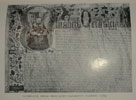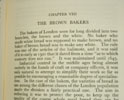A Short History of the Worshipful Company of Bakers of London
Half Title with the Worshipful Company of Baker's Crest.
FIRST EDITION 1933. 153x232mm. 2feps. Half title of Baker’s crest. [1] Title page. [1] v-vii Forward. [1] ix Author’s Preface. [1] xi Contents. [1] xiii Illustrations. [1] 1-170. 1p Photograph. [1] 171-172 Supplementary Notes. Photograph. [1] 173-176 List of Company Records. 177-182 List of Company Masters. p183 List of Company Clerks. 184-187 List of Benefactors. 188-189 List of the Company Livery. 190-201 Chapter Notes. 202-207 Index. 9p Decorative Scenes. 1fep. Twenty three pages of photographs and decorative scenes all with tissue guards. Red quarter calf binding with green cloth boards with bright gilt tooling on front board and spine (photo 1 below). Excellent condition externally and internally.
- During the year 1931-2, Frederick Abraham Mostyn became the Master of the Guild or Mistery of Bakers. He undertook the restoring and re-decorating of the ancient Company Hall after fifty years of neglect. As the Baker’s Company is one of the oldest and most venerable of the London livery companies, Mostyn also decided to put on record for the first time the history of the Company from its foundation. The earliest reference to the bakers is at the beginning of the reign of Henry II. The baker’s charter was granted by Queen Elizabeth I in1569. (photo 2 below) Mostyn approached Miss Sylvia Thrupp, M.A., Ph.D., of the London School of Economics. She had, circa. 1930 published an essay on ‘The Grocers of London’, a study that dealt with English Trade in the fifteenth century. She agreed to Mostyn’s request, although much of the history of ‘The Company of Bakers’ lay hidden in documents couched in mediaeval Latin and French scripts. Failing precise and trustworthy accounts of the origins of mediaeval craftsmen’s gilds, two of the main theories is, one, compounding for tolls and taxes, and two, the right vested in gild officers to supervise and govern the trade to which they were connected. From this historical basis Sylvia Thrupp starts, and takes the reader through a very interesting tour of the growth of the Company of Bakers up to 1933, the date of Mostyn’s forward at the beginning of the book. The list of company Masters on page 177 begins with John Jenyns who was in office from 1481-1489. This is not only the story of the bakers, but Thrupp has skilfully weaved in other significant livery companies of London. This allows us to see the Baker’s Company in the proper historical context of other venerable crafts. A wonderful book; Moyston chose his historical author well.




click on image to enlarge

Modern category
ref number:
11097